Source: Journal of Geophysical Research: Biogeosciences
Temperate forests have a reputation as crucial global carbon sinks. In fact, research suggests that American forests alone suck up the equivalent to 14% of annual carbon dioxide emissions in the United States. And after decades of net global forest loss, reestablishing forests worldwide is viewed as a viable option for mitigating the effects of climate change.
Beyond the carbon sequestration potential of reforestation, in many parts of the world, forests offer the added benefit of reducing surface temperatures by drawing water from the atmosphere and increasing heat transfer away from the surface. At a local level, restoring forests may help alleviate the effects of climate warming.
There is a distinction, however, between surface temperature and air temperature, and the science remains unclear as to whether reforestation also successfully lowers the air temperature. Whereas surface temperature is measured only at the surface, air temperature changes with height and may be influenced by changes in wind patterns caused by the forest canopy.
In a new study, Novick and Katul describe a novel approach to investigating both surface and air temperature on the basis of flux tower observations. The method accounts for canopy effects and uses tower measurements to estimate multiple metrics that link surface and air temperature. The research was conducted using data from three AmeriFlux sites in the Duke Forest in North Carolina. The researchers compared observations from colocated grassland, pine forest, and hardwood forest ecosystems, which represent the three phases of ecological succession in the region.
The study found that although air cooling from forests is not as significant as cooling on the surface, forest canopies still reduce air temperature near the surface by 0.5°C–1°C over a year. During the growing season, the warmest time of the year, forests reduce daytime near-surface air temperatures by 2°C–3°C. However, the effect was minimal at night.
By focusing on air and surface temperature, the study offers a more complete picture of how forests regulate temperature and cool landscapes than previous studies. The results should help communities better understand the benefits of reforestation and its upside as a climate mitigation tool. (Journal of Geophysical Research: Biogeosciences, https://doi.org/10.1029/2019JG005543, 2020)
—Aaron Sidder, Freelance Writer
Citation:
Sidder, A. (2020), Reforestation as a local cooling mechanism, Eos, 101, https://doi.org/10.1029/2020EO142166. Published on 02 April 2020.
Text © 2020. AGU. CC BY-NC-ND 3.0
Except where otherwise noted, images are subject to copyright. Any reuse without express permission from the copyright owner is prohibited.

